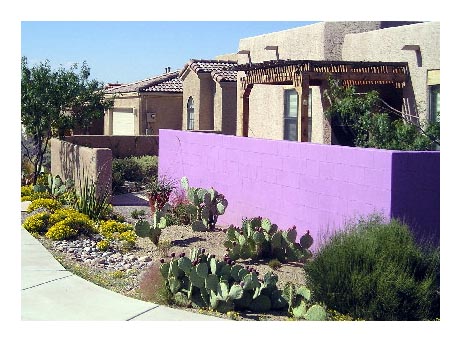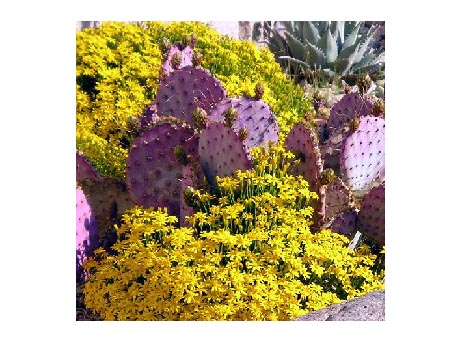
I share this garden (built by the quercus group) because, simply, this wall-cactus color combo stopped me in my tracks. I would never expect to see such exciting and vibrant colors in a desert landscape. WOW.
I’m not so good with cactii and desert plants, anyone care to identify these? Thanks.

The yellow flowers look like broom snake weed to me:
http://www.google.com/search?hl=en&safe=off&client=firefox-a&hs=m93&rls=org.mozilla:en-US:official&biw=1920&bih=1047&tbm=isch&sa=X&ei=1QqnTfShN5C8sQOW2LX6DA&ved=0CDMQBSgA&q=broom+snakeweed&spell=1
And the cactus is a purple prickly pear, perhaps Opuntia violacea:
http://www.google.com/search?q=Opuntia+violacea&hl=en&safe=off&client=firefox-a&hs=9Vj&rls=org.mozilla:en-US:official&prmd=ivns&tbm=isch&tbo=u&source=univ&sa=X&ei=PQunTbmPD5K6sAO3uOT5DA&ved=0CBcQsAQ&biw=1920&bih=1047
That’s David Cristiani’s own garden. He is the principle of Quercus Group and he’s really into using plants that are native and very site specific, so that they need almost no supplemental irrigation. The garden’s been on several garden tours. The vibrant palette is actually pretty common in a lot of desert landscape architecture these days. I think that Steve Martino in Phoenix started it with his Luis Barragan references. http://www.stevemartino.net/projects_res.html
The cactus is indeed Opuntia violacea and the plant with the yellow flowers is Chrysactinia mexicana “Damianita”.
How cool to see this here! The yellow flowers are indeed Damianita / Chrysactinia mexicana; but Snakeweed would work in cooler climates like Santa Fe, or here and points warmer, as well. Correct on the Opuntia violacea ‘Tubac’, AKA Opuntia santa-rita – it recently froze, including some on the west wall, but it left behind a very hardy hybrid, also purple – Opuntia macrocentra is hardier and can really be purple. Glad you enjoyed!